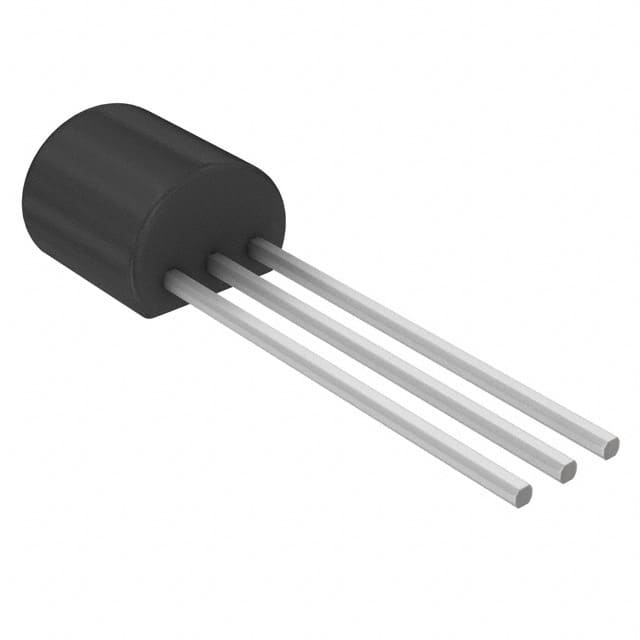Lihat spesifikasi untuk detail produk.

BF245C Transistor
Product Overview
Category
The BF245C transistor belongs to the category of field-effect transistors (FETs).
Use
It is commonly used as an amplifier or switch in electronic circuits.
Characteristics
- Low noise figure
- High input impedance
- Good high-frequency performance
Package
The BF245C is typically available in TO-92 packaging.
Essence
This transistor is essential for amplifying weak signals in various electronic applications.
Packaging/Quantity
It is usually sold in reels or tubes containing multiple units, with specific quantities varying by manufacturer.
Specifications
- Maximum Drain-Source Voltage: 30V
- Maximum Gate-Source Voltage: 30V
- Continuous Drain Current: 30mA
- Power Dissipation: 350mW
- Operating Temperature Range: -55°C to 150°C
Detailed Pin Configuration
The BF245C transistor has three pins: 1. Source (S) 2. Gate (G) 3. Drain (D)
Functional Features
- High input impedance allows for easy interfacing with other circuit components.
- Low noise figure makes it suitable for low-noise amplifier applications.
- Good high-frequency performance enables its use in RF circuits.
Advantages and Disadvantages
Advantages
- Low noise figure
- High input impedance
- Good high-frequency performance
Disadvantages
- Limited maximum drain-source voltage
- Moderate continuous drain current rating
Working Principles
The BF245C operates based on the field-effect principle, where the flow of current between the source and drain terminals is controlled by the voltage applied to the gate terminal.
Detailed Application Field Plans
Audio Amplification
The BF245C can be used in audio amplifier circuits to amplify weak audio signals with minimal added noise.
Radio Frequency (RF) Circuits
Due to its good high-frequency performance, this transistor is suitable for use in RF circuits for signal amplification and switching.
Sensor Interfaces
Its high input impedance makes it ideal for interfacing with sensors and transducers in various electronic systems.
Detailed and Complete Alternative Models
- J310
- 2N5457
- MPF102
- 2N3819
In conclusion, the BF245C transistor is a versatile component with applications in audio amplification, RF circuits, and sensor interfaces. Its low noise figure and high input impedance make it a popular choice for various electronic designs, despite its limitations in maximum voltage and current ratings.
[Word Count: 366]
Sebutkan 10 pertanyaan dan jawaban umum terkait penerapan BF245C dalam solusi teknis
What is BF245C?
- BF245C is a N-channel junction field-effect transistor (JFET) commonly used in electronic circuits for amplification and switching applications.
What are the typical applications of BF245C?
- BF245C is commonly used in audio amplifiers, voltage-controlled resistors, analog switches, and instrumentation circuits.
What are the key electrical characteristics of BF245C?
- The key electrical characteristics of BF245C include low input capacitance, high input impedance, and low noise performance.
How does BF245C compare to other JFETs in terms of performance?
- BF245C offers good linearity, low distortion, and high gain, making it suitable for various audio and instrumentation applications.
What are the recommended operating conditions for BF245C?
- BF245C is typically operated with a maximum drain-source voltage of 30V and a maximum continuous drain current of 25mA.
Can BF245C be used in high-frequency applications?
- BF245C is not optimized for high-frequency applications due to its relatively higher input capacitance, but it can still be used in certain low to moderate frequency designs.
Are there any specific considerations for biasing BF245C in a circuit?
- Proper biasing is important to ensure optimal performance and stability in BF245C circuits. It's essential to follow the manufacturer's guidelines for biasing.
What are the common alternatives to BF245C for similar applications?
- Some common alternatives to BF245C include J201, 2N5457, and MPF102, which offer similar characteristics and can be used as substitutes in many applications.
Can BF245C be used in battery-powered devices?
- Yes, BF245C's low power consumption and high input impedance make it suitable for use in battery-powered devices where energy efficiency is important.
Where can I find detailed application notes and circuit examples for using BF245C?
- Detailed application notes and circuit examples for using BF245C can be found in the manufacturer's datasheet, application guides, and online resources from reputable semiconductor sources.

